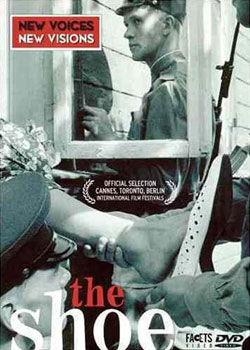
Three young soldiers discover a woman’s shoe on a sandy beach and chaos breaks out. Sirens go off, officers appear and hurried orders are shouted out. Welcome to Liepaja, Latvia, 1950. The new frontier. A time of paranoid suspicion, absurd reality and good old fashioned Latvian stoicism.
The story of Laila Pakalniņa’s Kurpe (The Shoe) reflects the absurdities of Latvian life in the early days of the Soviet occupation. This was the period in which the sand of Liepāja’s coastline was dredged each night by a tractor, like a conscientious golfer would a sand trap, and the following morning checked for fresh footprints.
When a pair of border guards discovers a woman’s shoe in the sand that wasn’t there the previous night, it could only mean one thing: a saboteur must have landed. It is the only possible explanation.
The commander of the border guards orders them, in classic Soviet fashion, to find the woman to whom the shoe belongs in the most direct manner possible. They are to traverse the city and to see whom the shoe will fit. A bit of Soviet Cochranism: “If the shoe will fit, you must convict.”
What ensues is an absurd tale that reflects the absurdities of Soviet life. Pakalniņa’s direction and cinematography perfectly complements the realities of the time. The film is an “art” film and as such might not appeal to those who are used to more traditional forms. There is very little dialogue and the plot assumes that the viewer understands the backstory. The shot selections often will often have the characters shot in silouethes or as reflections. The cinematography is in high contrast black and white.
However, for what it tries to be it is a nearly perfect film. The pacing and the style perfectly capture the helplessness and pragmatism of Soviet Latvian life. The ability of people to persevere with stoic resignation, all the while never quite submitting to their fate.
Pakalniņa’s background is in experimental and documentary films and it shows in the best possible way in this film. Kurpe resists the temptation to judge the period, but presents it in a straightforward manner allowing the audience to reach their own conclusions. Often films like this tend to be a bit heavy, but Kurpe never crosses the line.
Pakalniņa is greatly helped by the actors’ ability to appear natural. Their understated performances make the film’s absurd tone even more poignant.
In many ways this film shows how to accomplish a lot with a little. According to Pakalniņa, the story and the style were driven by the fact that she could not find the funding for some other projects and in the meantime decided to film a story with what she had available.
(Editor’s note: This review originally appeared on author Andrejs Makwitz’s Web site, The Latvian Film Page, and is republished with permission.)
Details
Kurpe
Laila Pakalniņa
Schlemmer Film GmbH, 1998
Notes: In Latvian and Russian. Drama, black and white, 83 minutes. Screenplay: Laila Pakalniņa; director of photography: Gints Bērziņš; editor: Sandra Alksne; producer: Christoph Meyer-Wiel; principal cast: Igors Buraks, Vadims Grossmans and Jaan Tatte.
© 1995-2024 Latvians Online
Please contact us for editorial queries, or for permission to republish material. Disclaimer: The content of Web sites to which Latvians Online provides links does not necessarily reflect the opinion of Latvians Online, its staff or its sponsors.




